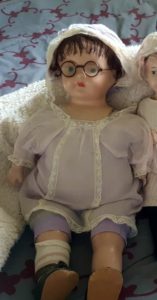 SK sends me an antique doll with spectacles, rather intelligent but haughty. Writing about dolls with spectacles, and why that became a fashion in the first quarter of the 20th century amuses me.
SK sends me an antique doll with spectacles, rather intelligent but haughty. Writing about dolls with spectacles, and why that became a fashion in the first quarter of the 20th century amuses me.
The history of spectacles are embodied in this doll. Since the 13th century humans have had vision aids, such as the single glass, called a ‘quizzing’ glass, the double glass, called the “scissor” glass, and, the spectacles we wear today, called “temple” frames. This doll wears the NEW fashion of celluloid temple glasses. Celluloid used for eyeglasses became a new thing in those days. We consider this doll fashionable because she wears the latest.
To understand this doll, we must understand the revolution of semi-synthetic, moldable thermoplastics, invented in the later part of the 19th century.
It all started with billiard balls. Elephants died in record numbers at the same time billiard gained in popularity. Manufactures used ivory to make the balls. A concerned billiard company offered a reward to any one scientist who came up with a substitute for ivory for billiard balls. John Wesley Hyatt (1837-1920) won the prize for his invention of a ball of shellac and bone dust, and then refined his process to create a better ball of base cotton paper, shellac and camphor, coated with Collodion. Yes, that’s the same chemical used for wet plate photography of the era.
Hyatt cornered the market on cheap sustainable billiard balls, then he branched out, forming the Celluloid Manufacturing Company, to make false teeth. Hyatt, throughout his life in Newark, New Jersey, invented many things. He held at one point 236 patents, second only to the inventory of Thomas Edison.
Any manufacturer who used expensive ivory took notice. Soon companies used celluloid to make once-ivory items such as:
- handles of knives
- backs of brushes and accompanying dresser sets
- chess pieces
- umbrella handles
- and, due to the heat molded ability, eyeglasses
Hence the bespectacled baby doll.
If your doll didn’t come complete with celluloid eyeglasses, you ordered a pair through mail order for 15 cents. And you bought yourself a pair for about the same amount. All of a sudden, eyeglasses, once made of gold or silver, became affordable.
Hyatt, however, never claimed the prize money. He stayed too busy inventing. His final accolade came in 1973, 53 years after his death. That year, the Billiard Congress of America inducted him into their Hall of Fame.
Celluloid took over the decorative arts world in the late 19th and early 20th century. Girls afforded fancy costume jewelry made from this bright and durable material. Men afforded to dress with upright collars of celluloid insets. Children played with colorful toys. Everyone owned a fancy dresser set, or pair of dice, or, in an alarming turn of fate, sport a match safe which held matches and included an outside striker made of celluloid.
Why do I say “alarming” for a match safe of celluloid? Celluloid is highly flammable. Hyatt’s company in Newark experienced 39 fires in 36 years, killing nine workers, caused by heating that nitro-celluloid. Likewise, your match safe or your children’s toys had a propensity to swell and emit deadly camphor fumes if heated over 100 degrees. Tales were told of sitting by a fire in a dress with buttons on fire, or exploding shirt collars. As an alternative to laundering linen for your shirt collar and cuffs, a gentleman attached a piece of molded celluloid that he wiped down each day. The problem became severe if the same gentleman smoked. People who collected celluloid buttons might burn a house down if they kept the buttons in a sealed jar.
Finally, we come to the most flammable use of the material, celluloid film. The motion picture industry built their fortune on highly flammable celluloid film. A theater at the time had its risks. Moving pictures might set the whole theater on fire, and often did. Once they extinguished the fire, the theater became beset with fumes.
So we see SK’s little bespectacled doll tells the story of a material destined to take over the world. Celluloid substituted for very expensive materials such as ivory, tortoise shell, coral, amber, jade, sometimes inset with fake gems, sometimes with real gems. But the problem remained until the 1940’s, it might set you on fire.
The value of the doll, beyond its notability as a harbinger of fashion in eyewear of 1910, is $200.